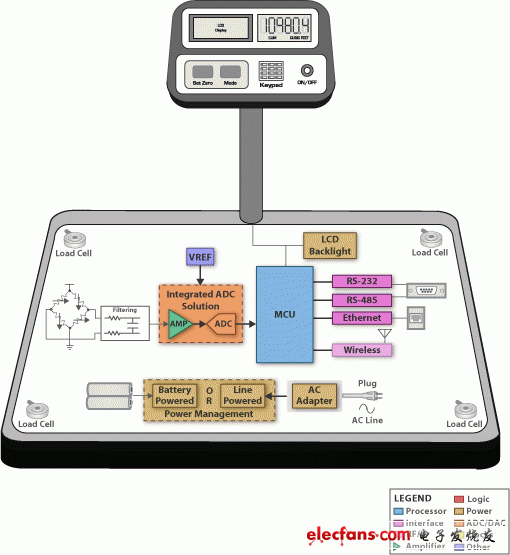Texas Instruments (TI) Weighing Balance Solutions
Design considerations
Weighing balance / bridge sensor:
Electronic scales exist in many industrial applications in some ways or forms, and are found everywhere in today's food industry. Electronic scale manufacturers occasionally develop dedicated ASICs to customize the functionality of the analog front end for maximum accuracy and stability. However, some design methods using standard products offer up to 23 bits of noise-free code resolution, which is comparable to custom solution functionality.
Block diagram

The main challenge in the design of electronic scales is not only to sample multiple load cells, but also to provide extremely low input reference noise (RTI). The ADS1230, ADS1232, and ADS1234 provide the low input reference noise required for this application. Another important factor is the long-term stability of the analog circuit in terms of offset drift and gain, timeout and temperature. Since realistic sensors have span and offset errors, the temperature will constantly change. In addition, many bridge pressure sensors have a non-linear output due to external forces. It must be ensured that the accuracy of the amplified input signal (single-ended or differential) does not decrease over several years. Auto-zero amplifiers, such as the OPA335 and INA326 instrumentation amplifiers, can easily meet these demanding requirements by achieving offset drift of 0.05μV/°C (OPA335) and 0.4μV/°C (INA326).
The bridge sensor converts the physical value into a differential signal in the mV/V range and is considered a metal thick film, ceramic or piezoresistive sensor. However, they are non-linear sensors that are temperature dependent and have large offset and offset drift. In addition, they need to pay attention to electronic calibration and compensation. The bridge excitation linearization circuit is optimized for the nonlinearity of the bridge pressure in a parabolic shape. Although the linearization circuit is usually a digitally programmable circuit, the processing of the pure analog signal conditioning terminal is accomplished by adjusting the analog signal chain. In addition, calibration parameters need to be stored in an external non-volatile memory to eliminate manual fine-tuning and achieve long-term stability.
Features provided by the MSP430 microprocessor or TMS320C550x DSP include computation and signal processing, user-friendly interfaces such as LCD display and keyboard control, and wireless/wired data transmission and connection interfaces.
Shenzhen Isource lighting Co., Ltd , https://www.isourceled.com
